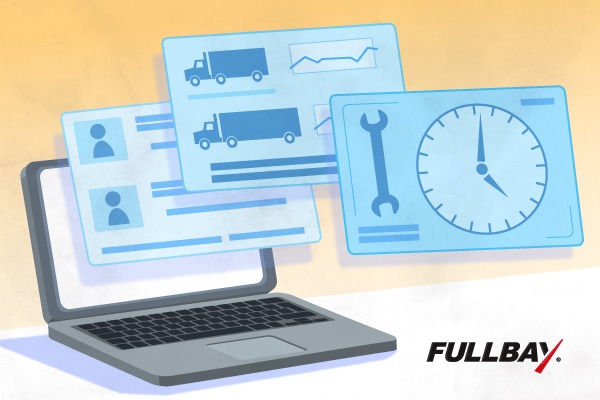A Brief History of Labor Guides

Whether you’re a fleet manager or a shop owner, you can probably agree that time is money.
When you bring a truck into the shop for maintenance or repairs, you expect that shop to provide an estimate of how much time it will take and how much it will cost. The time a tech will spend on a particular procedure isn’t just made up on the spot, though. Most shops reference labor guides when determining how long a repair will take.
What is a labor guide? We’re so glad you asked…
What is a labor guide?
If labor guides are old news to you, please feel free to skip on ahead to our riveting history section. But if you’ve got questions about labor guides and what they are, stay right here.
Boiled down to its most basic form, a labor guide is just that: a guide to how much of a mechanic’s time should go into a repair or procedure, from oil changes to transmission replacement and everything in between. It protects the time and income of techs and shops, as well as the time and money of customers who bring their vehicles in for service.
Let’s say a labor guide states that it will take one hour to complete an oil change (we know it doesn’t state that, but bear with us). You bring in your truck and the rate that the shop charges is for that hour of a tech’s time. Whether the oil change is completed before or after that hour, you’re still paying the same rate — unless it goes horrifically over, in which case there’s probably some sort of problem in play. Meanwhile, the tech can work knowing they’ll be paid for their time and expertise, even if they knock the oil change out in 15 minutes.
An added benefit of labor guides is that if a customer does kick up a fuss over how long a repair will take (and consequently how expensive it is), a shop owner can whip out the guide (or fire it up on the computer) and point right at the time estimation.
In the past, labor guides appeared as manuals and magazines you could keep on a shelf and refer to when necessary. Some have made the leap into technology, appearing first on CDs and lately as parts of other trucking and auto-related software and products.
The history of labor guides
Labor guides have probably been around in some form or another for centuries, but automotive and heavy-duty labor guides are a fairly recent invention. Let’s have a look at the big four labor guides we still refer to in the twenty-first century.
Chilton
The granddaddy of the current generation of labor guides is undoubtedly Chilton. It was first referenced as a publishing company in 1904, and was founded by James Artman, George Buzby, and C.A. Musselman. Here’s a curious tidbit: Chilton has the…interesting… distinction of being named after one of the first Mayflower passengers to die at Plymouth.
Fortunately, Chilton did not follow in the footsteps of its namesake; it went on to publish Commercial Car Journal and Automobile Trade Journal, among others. Through the decades the company was bought and sold, and its titles varied, but it amassed quite a lot of repair manuals.
Motor
Just behind Chilton in terms of fame is MOTOR. In 1903, William Randolph Hearst — yes, the guy with the castle — married Millicent Wilson. For their honeymoon they traveled across Europe by automobile. The trip must have been an eventful one, because upon his return Hearst was inspired to start THE MOTOR. Yes, folks, this labor guide was a honeymoon baby.
Through all its success, The Hearst Corporation has kept its commitment to the automotive industry. Today MOTOR is the only labor guide still run by its founding company.
Mitchell 1
Mitchell 1 has an interesting background full of ownership and name changes. We can trace its beginnings to 1918 when it operated under the name of Reed Electrical Manuals; over the years it was part of (and then spun off from) the company that became Mitchell International. That company, founded by Glenn Mitchell in 1946, produced a catalogue to assist in automotive repair. This particular catalogue had a neat innovation: it listed parts not just by component, but by the quadrant they were located in the vehicle.
Alldata
Alldata is a spring chicken compared to the others — it arrived in 1986, when a group of auto professionals in Elk Grove, California envisioned a way to leverage technology in a way Chilton, MOTOR, and the Mitchells weren’t at the time. In 1996, AutoZone bought the company and still runs it today.
Which labor guide should I use?
We’re not in the business of making official recommendations, but our particular favorite is MOTOR because it hits two critical points for us.
- It carries class 4-8 vehicles — some of the guides above don’t
- It lives in the cloud, which means you can access it anywhere
Mitchell 1 comes in second, and also happens to round out the list, as it’s the only other provider of labor information on class 4-8 vehicles.
Should I use a labor guide or shop management software?
Ideally, both!
Labor guides help you avoid under-billing jobs. Shop management software helps you do those jobs as efficiently as possible. That ultimately means more money left in everyone’s pocket: the customer, the tech, and the shop. That doesn’t mean shop management software and a labor guide need to be used together. But we like the idea of keeping your software open in one tab and the labor guide open in another.
Do you have a labor guide but not shop management software? We can help you out there! Request a demo and give Fullbay a try alongside your labor guide.

